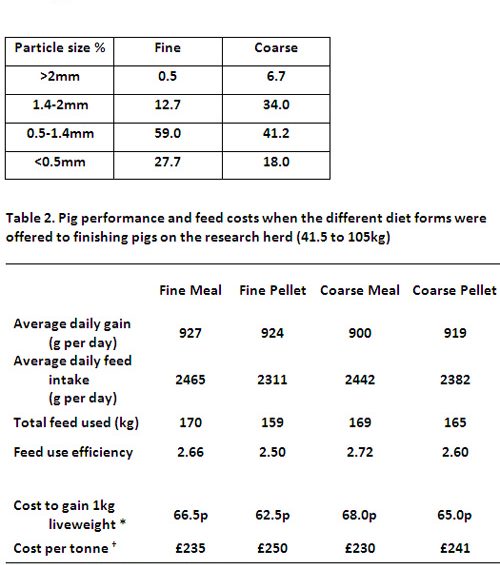Feed in meal or pellet form for pigs

Large economic differences exist when feed is offered to pigs in either meal or pellet form and when diets are either finely or coarsely ground. This is one of the main findings from a large trial recently completed by the Agri-Food and Biosciences Institute (AFBI) Hillsborough through the research consortium of John Thompson and Sons Ltd, Devenish Nutrition Ltd and Preferred Capital Management (PCM) with co funding from the Department of Agriculture and Rural Development.
Diets made by compounders are commonly finely ground and in pellet form, whereas diets made in home mixing operations are normally more coarsely ground and usually in meal form. As expected it takes more energy, and is therefore more expensive, to produce a finely ground pellet compared with a coarsely ground meal diet, aside from the extra mechanical equipment required. However, previous research has suggested that offering pigs feed in pellet form improves feed use efficiency. Furthermore, other research studies suggest that when particle size within the feed is small (i.e. fine) feed use efficiency is better than when the particle size is large (i.e. coarse). However, few studies have investigated if these two processes i.e. pelleting and fine grinding, have cumulative benefits on feed use efficiency.
In the current study, two trials were conducted. In both trials the ingredients (main ingredients being Barley (41%), wheat (36%) and soya (19%)) and nutrient specification (digestible energy of 13.6MJ per kg, crude protein of 16.7% and total lysine of 9.6g per kg) of all diets were the same. The only differences between the diets was the ‘form’ they were offered in i.e. meal or pellets and the particle size within them i.e. ‘fine’ or ‘coarse’. The finely ground diets were manufactured using six 4mm screens and the coarsely ground diets were made using a combination of two 14mm and four 10mm screens. The particle size profile of the diets after ‘fine’ or ‘coarse’ grinding is reported in Table 1. The coarsely ground diets had a similar particle size profile as those generally adopted in home milling operations. In both trials, pigs were offered feed from a wet and dry single space feeder (Verba feeder).
In trial 1, when pigs on a commercial farm in mid Ulster (Tempo and PIC337 crossbred pigs used) were offered feed in either meal or pellet form, their growth rate between 55 and 110kg was similar (881g per day). However, although there was no significant difference, a numerical improvement of 3% in feed use efficiency was observed when pellets were offered instead of meal. On the commercial herd, there were issues regards separation of the meal diet due to the blowing of the diets into the bulk bins. Although these issues were reduced when the feed was blown in with less force, it does raise concerns regards the use of meal in auger systems.
In trial 2, pigs on the AFBI research herd (Tempo crossbred pigs) were offered diets which were either finely or coarsely ground and in either meal or pellet form. Table 2 reports the performance of pigs and feed cost calculations when these 4 diets were offered on the research herd. Similar to the effect on the commercial herd, the growth rate of pigs was similar for all diets (917g per day) (Table 2). However, daily feed intake was lowered by 4.5% and feed use efficiency was improved by 5.5% when pellets were offered compared with meal in trial 2 (Table 2). Feed use efficiency was also improved (by 3.1%) when the particle size was ‘fine’ compared with coarse (Table 2). The beneficial effects of pelleting and fine grinding appear to be cumulative and economically large differences in feed cost were calculated
(Table 2). This study suggests that a £20 per tonne differential in diet cost is required in order to compensate for the deterioration in feed use efficiency when a ‘coarse meal’ was offered compared with a ‘fine pellet’. Overall, it cost an extra 1.8p to gain each kilogram of live weight during finish when meal was offered compared with pellets. There was no effect of diet form (meal or pellets) or particle size (fine or coarse) on stomach ulceration in either trials. Furthermore, there were no effects on carcass quality i.e. back fat depth or kill out percentage.
Conclusion
In agreement with previous research, feed use efficiency was improved when diets were offered in pellet form instead of in meal form. When the particle size within the diet was ‘fine’, feed use efficiency was also improved compared with when particle size was ‘coarse’. Furthermore, the effect of pelleting and fine grinding appeared to be cumulative and economically large differences in feed costs would be required to compensate for differences in feed use efficiency.
By Elizabeth Magowan, Agri-Food and Biosciences Institute, Hillsborough











